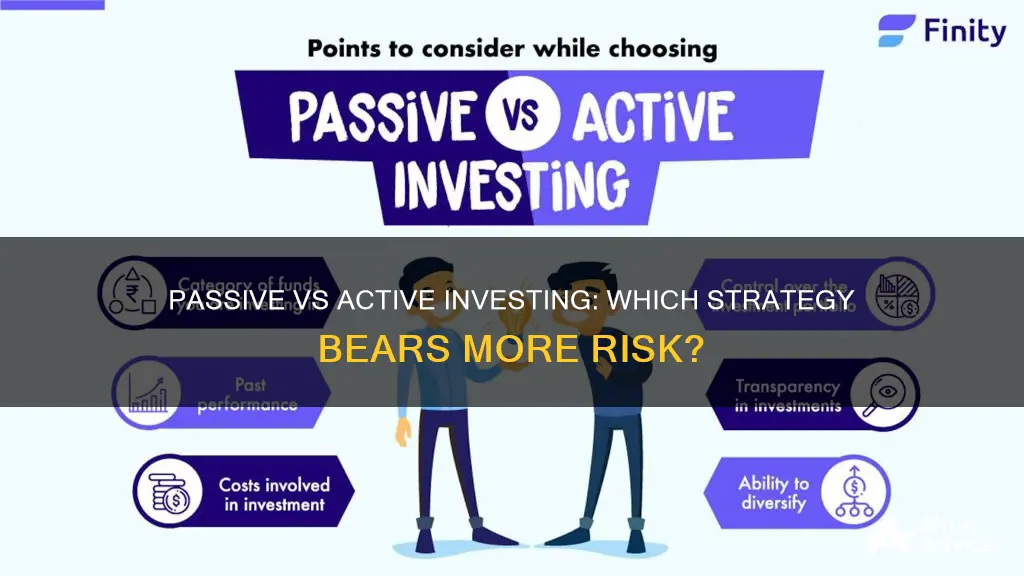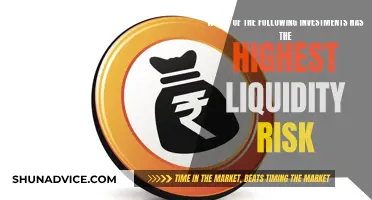
Passive investing and active investing are two distinct investment strategies with different levels of risk. Passive investing is a long-term, low-cost strategy that aims to replicate the performance of a specific market index, like the S&P 500, by holding a fixed portfolio. It's a more hands-off approach with limited transactions, aiming to match the market rather than beat it. On the other hand, active investing is a more hands-on strategy that involves frequent buying and selling of assets with the goal of outperforming the market by capitalising on short-term price fluctuations.
Passive investing is often considered the less risky option as it diversifies investments across a market index, reducing the impact of market downturns. It also tends to have lower fees and is more tax-efficient due to fewer transactions. However, it may result in smaller short-term returns as it rarely outperforms the market.
In contrast, active investing offers more flexibility and the potential for higher returns but comes with increased risks and costs. Active investors need to monitor the market closely and make timely decisions, which can lead to higher transaction costs and management fees. While active investing aims to beat the market, it often underperforms passive investing over the long term due to higher fees and taxes.
Both strategies have their advantages and disadvantages, and the level of risk depends on an individual's financial goals, risk tolerance, and investment horizon.
| Characteristics | Passive Investing | Active Investing |
|---|---|---|
| Goal | Match the market | Beat the market |
| Best for | Beginners | Experienced investors |
| Trading frequency | Infrequent | Frequent |
| Fees | Lower | Higher |
| Risk | Lower | Higher |
| Returns | Lower | Higher |
| Management style | Buy-and-hold | Actively managed |
What You'll Learn

Active investing: higher fees, higher risk, higher returns
Active investing is a strategy that aims to beat the market by actively managing an investment portfolio. It involves frequent decision-making, monitoring, and buying and selling of investments. While it offers the potential for higher returns, it also comes with higher fees and a greater risk of losses.
Higher Fees
Active investing involves more frequent trading and requires a portfolio manager or financial advisor, which results in higher management fees, transaction costs, and salaries for analysts. These expenses can accumulate over time and eat into investment returns.
Higher Risk
Active investing carries a higher risk due to its focus on short-term price fluctuations and the potential for human error. The pursuit of higher returns can lead to increased volatility and the possibility of more significant losses. The performance of active investing also depends on the skill and market predictions of the portfolio manager, introducing an element of uncertainty.
Higher Returns
Active investing offers the potential for higher returns by actively selecting investments that differ from the market index and taking advantage of short-term market opportunities. This flexibility allows active investors to adapt their strategies and target high-return opportunities.
In summary, active investing involves higher fees due to its hands-on nature and the need for professional expertise. It carries a higher risk because of its focus on short-term gains and the potential for mistakes in decision-making. However, it also offers the prospect of higher returns by actively managing the investment portfolio and capitalizing on market opportunities.
Smart, Quick Investment Turnarounds: A Guide to Success
You may want to see also

Passive investing: lower fees, lower risk, lower returns
Passive investing is a long-term investment strategy that aims to build wealth gradually by buying and holding a diverse portfolio of investments. It seeks to match market returns and relies on the assumption that the market will post positive returns over time. This approach is often associated with index investing, where investors aim to replicate the composition of a specific market index.
Lower Fees
Passive investing typically involves lower fees compared to active investing. This is because passive funds require less active management and have lower operating costs. Actively managed funds, on the other hand, involve higher transaction costs and fees due to the extensive time and effort invested by professional fund managers.
Lower Risk
Passive investing is considered a lower-risk strategy than active investing. By investing in a diverse portfolio that mimics the market, passive investors reduce the risk associated with individual stock picking. Additionally, passive funds tend to have lower expense ratios and generate fewer taxable events, resulting in lower taxes for investors.
Lower Returns
While passive investing offers lower fees and reduced risk, it also comes with the potential for lower returns compared to active investing. Passive funds aim to match the market rather than outperform it, and they rarely beat their benchmark index. In contrast, active investing aims to beat the market, and active fund managers have the flexibility to adapt to changing market conditions and take advantage of short-term opportunities.
Equity-Based Compensation: Investing, Operating, or Financing?
You may want to see also

Active investing: flexibility and trading strategies
Active investing is a hands-on approach to investment management. It requires frequent decision-making and monitoring of one's portfolio. Active investors often work closely with financial advisors and aim to beat the market.
Active investing offers flexibility and a range of trading strategies. Active managers are not required to follow a specific index and can buy stocks they believe will perform well. This flexibility allows active investors to adjust their portfolios in response to market changes or new opportunities. They can also employ hedging strategies, such as short sales or put options, and exit specific stocks or sectors when the risks become too high.
Active investing also allows for tax management strategies. While it can trigger capital gains taxes, advisors can tailor strategies to individual investors, such as selling investments that are losing money to offset taxes on profitable investments.
Active investors can adapt to adverse market conditions and are willing to shift positions to benefit from them or protect themselves. They can take advantage of short-term trading opportunities and use swing trading strategies to trade market ranges or exploit momentum.
However, active investing can be costly due to the potential for numerous transactions. It also carries higher fees, as it involves more hands-on management and requires paying the salaries of the analyst team.
Young Investors: Embrace Risky Ventures?
You may want to see also

Passive investing: tax efficiency
Passive investing is a tax-efficient strategy, as it involves less frequent buying and selling of investments, which can result in fewer taxable transactions. This is particularly beneficial when funds are held in taxable accounts, such as non-retirement brokerage accounts.
Passive investing typically involves a buy-and-hold strategy, where investors select stocks or funds and resist the temptation to react to short-term market movements. This approach can result in fewer taxable events, such as capital gains, and ultimately lower taxes paid by investors.
Index funds and exchange-traded funds (ETFs) are commonly used passive investment vehicles known for their tax efficiency. They are designed to track the performance of a specific index, resulting in lower turnover rates compared to actively managed funds. ETFs also utilise a process called in-kind redemptions, which helps reduce the likelihood of capital gains distributions and lowers the tax burden on investors.
Additionally, passive investing can provide tax efficiency through qualified dividends. Many stocks held within index funds and ETFs pay qualified dividends, which are taxed at lower capital gains tax rates rather than ordinary income tax rates. This can be especially beneficial for long-term investors.
Furthermore, passive investing can be tailored to an investor's unique circumstances and objectives. Tax-efficient strategies, such as tax-advantaged accounts (like IRAs and 401(k)s), tax-loss harvesting, and managing the timing of capital gains and withdrawals, can help maximise after-tax returns and enhance portfolio longevity.
By integrating tax-efficient strategies, passive investors can preserve and grow their wealth over time, making it an attractive option for those seeking a low-maintenance approach to building wealth.
Growth Equity: Smart Investment for Long-term Business Success
You may want to see also

Active investing: tax-loss harvesting
Active investing is a hands-on approach to managing your investments. It requires frequent decision-making and monitoring of your portfolio. Active investors are often willing to pay more for a shot at higher returns. They also tend to have a higher tolerance for risk and prefer a more hands-on approach to building wealth.
Tax-loss harvesting is a strategy that allows active investors to reduce their tax liability by selling investments at a loss to offset gains made from other investments. This strategy is particularly useful for active investors who frequently buy and sell securities, as it can minimise their tax burden.
Here's how tax-loss harvesting works:
- Cultivate the tax savings: Review your portfolio for investments that have declined in value.
- Prune the portfolio: Sell the underperforming asset to realise the loss, which can then be used for tax purposes.
- Reap the benefits: Use the realised loss to offset capital gains from other investments. You can deduct up to $3,000 from your ordinary income if your losses exceed gains.
- Sow the seeds for future gains: Reinvest the proceeds from the sale into a similar but not identical asset to maintain your desired market exposure.
It's important to note that tax-loss harvesting defers taxes rather than eliminating them. Lowering the cost basis of investments can lead to larger capital gains in the future. Additionally, be mindful of the wash sale rule, which prohibits repurchasing a "substantially identical" security within 30 days before and after selling at a loss.
Tax-loss harvesting can be a powerful strategy for active investors, but it may not be suitable for all. It's important to carefully consider the rules, benefits, and potential pitfalls before employing this strategy. Consulting a financial advisor or tax professional is recommended to ensure it aligns with your financial goals and risk tolerance.
Making Your RRSP Investment: Eligibility Factors to Consider
You may want to see also
Frequently asked questions
Passive investing is a low-cost, long-term investment strategy that aims to match the performance of a specific market index, such as the S&P 500. It involves buying and holding investments with minimal portfolio turnover, limiting transactions, and focusing on long-term growth.
Active investing is a hands-on approach to investment management. It involves buying and selling assets based on short-term performance and market trends, with the goal of outperforming the market. Active investors frequently monitor their portfolios and make changes as they see fit.
Passive investing offers benefits such as lower fees, tax efficiency, and transparency. However, it may result in less control over your portfolio and potentially smaller short-term returns compared to active investing.
Active investing offers advantages including flexibility, risk management, and the potential for higher returns. On the other hand, it may lead to higher fees, unpredictable fund performance, and increased investment risk.
Passive investing is generally considered lower risk compared to active investing. Passive investing aims to replicate the performance of a market index, providing more stable returns. Active investing, on the other hand, involves taking advantage of short-term price fluctuations, which can lead to higher risk and potential losses.







